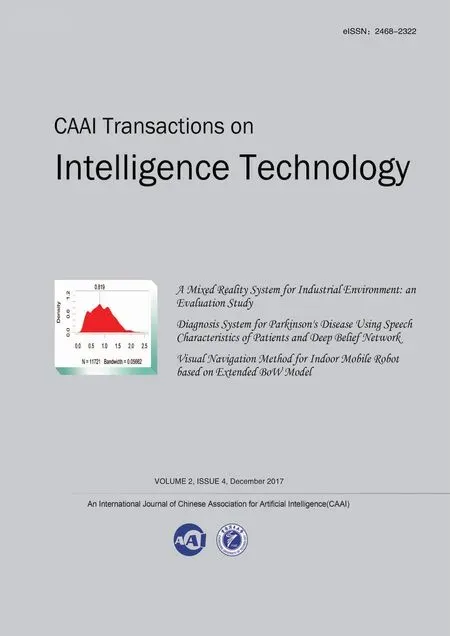Editorial: Recent Advances in Intelligent Robotic Systems
Xin Xu, Yong Liu
Intelligent robotic systems(IRSs) have attracted more and more attention in the past decades since IRSs have great potential to be widely applied in industry, agriculture, transportation, medical operations and service. However, due to the increasing complexities and uncertainties in real-world tasks, there are still many research challenges in the sensing, planning and control of intelligent robotic systems. In order to promote the research in this area, we organize this special issue which includes six papers. These six papers are extended peer-reviewed versions from selected papers that have been presented in the 2017 Chinese Conference on Intelligent Robots. The topics of the special issue papers cover a wide range from robot sensing, visual navigation, to robot control and service robots. We believe that this special issue will provide a good forum and reference for researchers in the field of intelligent robotics.
The first paper in this special issue presented a visual navigation method that uses an extended Bag-of-Words (BoW) model for feature representation and support vector machines for object classification[1]. The interaction between human and robot was also considered by considering the manually designed semantic maps. Some experimental results on indoor mobile robot navigation were provided to show the effectiveness of the proposed method.
The second paper proposed an initiative service model for service robots[2]. In the proposed service model, there are three layers that are designed for human-robot interaction. Experiments on drinking service were conducted to verify the advantages of the initiative service model.
In order to realize high-performance sensing for autonomous vehicles, the third paper presented a lane detection algorithm by making use of temporal-spacial information matching and fusion[3]. Experimental results on a real autonomous vehicle show that the proposed algorithm can obtain high-precision and stable lane detection results.
The forth paper in this special issue focused on the dynamics modeling for robot trajectory planning and control, where an evaluation method based on Lie Group was proposed for generalized force derivatives of industrial robots[4]. The main merits of the proposed approach include its conciseness and computational efficiency. Some simulation results were also provided.
The fifth paper designed a magnetic orientation system by integrating gyroscope, accelerometer, and magnetometer[5]. The Kalman filtering algorithm was utilized to fuse the data from different sensors. Experimental results were provided to test the performance of the magnetic orientation system.
The last paper in this special issue proposed an indoor localization method for mobile robots with inertial measurement units and stereo vision[6]. In the proposed method, the dual Kalman filtering method was used to decrease the accumulation errors of inertial measurement units. Experimental results on a real mobile robot show the effectiveness of the proposed method.
[1]Xianghui Li, Xinde Li, Mohammad Omar Khyam, Chaomin Luo, and Yingzi Tan, Visual Navigation Method for Indoor Mobile Robot based on Extended BoW Model,CAAITransactionsonIntelligenceTechnology, vol.2, no.4, pp.256-264, 2017.
[2]Man Hao, Weihua Cao, Min Wu, Zhentao Liu, Jinhua She, Luefeng Chen, and Ri Zhan, Proposal of Initiative Service Model for Service Robot,CAAITransactionsonIntelligenceTechnology, vol.2, no.4, pp.265-274, 2017.
[3]Jun Wang, Bin Kong, Tao Mei, and Hu Wei, A Lane Detection Algorithm Based on Temporal-Spatial Information Matching and Fusion,CAAITransactionsonIntelligenceTechnology, vol.2, no.4, pp.275-291, 2017.
[4]Kun Yang and Wenyu Yang, An Efficient Approach for the Evaluation of Generalized Force Derivatives by Means of Lie Group,CAAITransactionsonIntelligenceTechno-logy, vol.2, no.4, pp.292-300, 2017.
[5]Zhiwei Chu, Chilai Chen, Youjiang Liu, Yingxian Wang, and Xinhua Lin, Magnetic orientation system based on magnetometer, accelerometer and gyroscope,CAAITransactionsonIntelligenceTechnology, vol.2, no.4, pp.301-310, 2017.
[6]Lei Cheng, Biao Song, Yating Dai, Huaiyu Wu, and Yang Chen, Mobile robot indoor dual Kalman filter localization based on inertial measurement and stereo vision,CAAITransactionsonIntelligenceTechnology, vol.2, no.4, pp.311-323, 2017.
 CAAI Transactions on Intelligence Technology2017年4期
CAAI Transactions on Intelligence Technology2017年4期
- CAAI Transactions on Intelligence Technology的其它文章
- Mobile Robot Indoor Dual Kalman Filter Localization Based on Inertial Measurement and Stereo Vision
- A Lane Detection Algorithm Based on Temporal-Spatial Information Matching and Fusion
- Proposal of Initiative Service Model for Service Robot
- Visual Navigation Method for Indoor Mobile Robot Based on Extended BoW Model
- Diagnosis System for Parkinson’s Disease Using Speech Characteristics of Patients and Deep Belief Network
- A Mixed Reality System for Industrial Environment: an Evaluation Study
